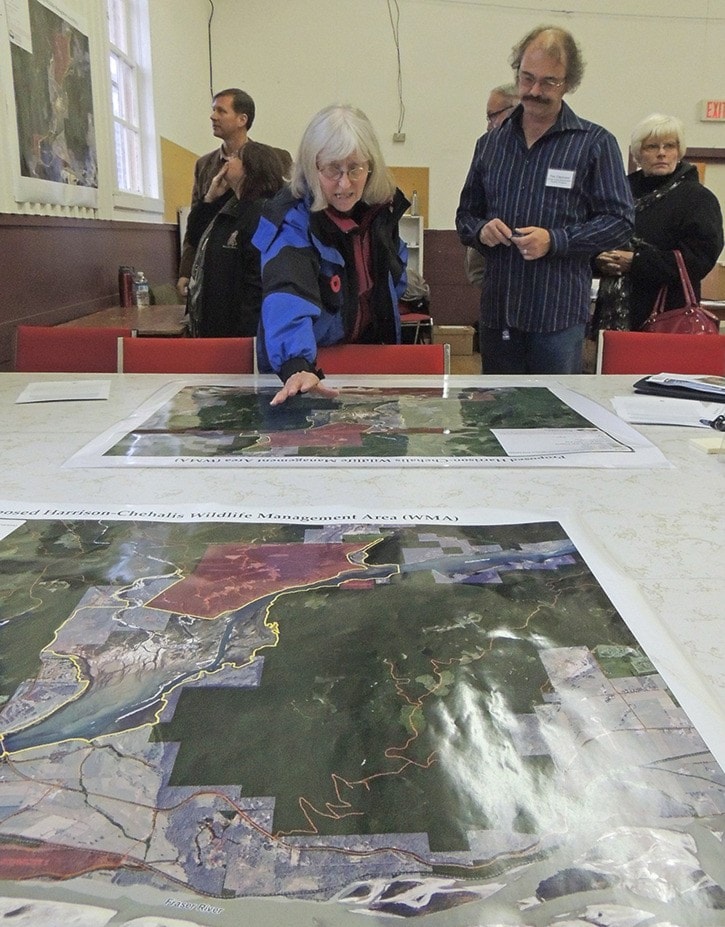Resistance continues to build against a proposed Wildlife Management Area for the Harrison-Chehalis river and surrounding lands.
The District of Kent is most notably opposed to the plan to designate more than 1500 hectares as a WMA, a provincial government initiative that has been in the works since at least 1997. As recently as this January, the District informed the Ministry of Forests, Lands and Natural Resources that they were not in support of the WMA designation, citing numerous concerns that such a designation will make their efforts at ditch maintenance and river management even more difficult. And now, an open house held last Friday, which kicked off a 45-day consultation process, has done little to quell the worries of detractors of the initiative. The government has seemed to ire people right off the bat, with short notice for the important meeting. "The notice was very short," Councillor Lorne Fisher said at this Tuesday's council meeting. A letter was sent on Oct. 25 from Jeff Juthans, the regional initiatives officer in charge of the project, for the Nov. 7 meeting. "And it seemed to be selected, who knew about it. It was mostly supporters (in attendance)," said Fisher, who attended the open house at the Harrison Mills Community Hall. One woman at that open house spoke angrily to Juthans, stating that Chief Andy Phillips of the Scowlitz First Nation was not informed of the meeting. Phillips was away this week, and did respond to a request for an interview by The Observer. However, the map includes land that abuts Scowlitz reserve, and includes a beach area that the woman stated is Scowlitz land. Another woman who asked not to be named said that the people of Harrison Mills are frustrated with the water that seeps into their land. "We were the canary in the coal mine," she said, when they stopped dredging the Fraser River regularly. "But we are a small but powerful community." The District of Kent's main concern will be the level of control that the provincial government will have over any activities in a WMA, if it were to be put into effect. Most concerning for the District of Kent, and those who live on the land abutting the Harrison and Fraser confluence, is river maintenance. "If we can't dredge the river, our feet get wet every spring," Fisher said. In the letter sent to Juthans in January, Mayor John Van Laerhoven stated "the District's primary concern is the additional regulatory requirements that may result from the Harrison-Chehalis WMA designation, which may further obstruct our ability to conduct regular drainage and dyke maintenance operations." He underlined that the District's "annual drainage maintenance program is already significantly compromised due to excessive environmental permitting requirements." Resident and Rod and Gun Club member Kelvin Scott said the community rallied against the proposal in 2002, for the same reasons. "If this proposal is allowed to proceed, what will be the effects to current and future community planning, lifestyles, privileges of land usage, zoning developments, user groups and compliance issues?" he asked council on Tuesday. At the open house, Juthans conceded that discussions between local government, First Nations bands and the province have not been positive in the past. "I admit that historically, relationships have been difficult," Juthans said. But he said the WMA is meant to give everyone "shared stewardship" as the province writes a management plan for the area. "Anyone will tell you this is a special area," he said. Well known biologist David Hancock attended the open house, and said the Harrison is the "most important river in Canada." He said the idea of taking gravel out the rivers to mitigate flooding "are only the words of someone wanting to take gravel out. There's enough gravel. They don't need it from here."Next week, a special event will take place to designate the Harrison River as a Salmon Stronghold. The Harrison Chehalis flats have already been named a preserve area, through the help of Hancock's Fraser Valley Bald Eagle Festival Society. Signage is being put up through the area to remind people to stay off the flats, and a large group of locals are going through interpretive training, so they can pass knowledge along to visitors. The 45 day consultation process ends on Dec. 21. Individual written submissions related to the WMA should be sent to Jeff.Juthans@gov.bc.ca. Council and staff are hoping that many people will take the time to write in, to again defeat the WMA. Scott echoed that feeling. "The clock's ticking hard on us," he said.
